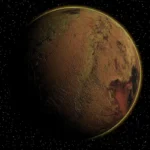
This magnificent 360-degree panoramic image, covering the entire southern and northern celestial sphere, reveals the cosmic landscape that surrounds our tiny blue planet. This gorgeous starscape serves as the first of three extremely high-resolution images featured in the GigaGalaxy Zoom project, launched by ESO within the framework of the International Year of Astronomy 2009 (IYA2009). The plane of our Milky Way Galaxy, which we see edge-on from our perspective on Earth, cuts a luminous swath across the image. The projection used in GigaGalaxy Zoom place the viewer in front of our Galaxy with the Galactic Plane running horizontally through the image — almost as if we were looking at the Milky Way from the outside. From this vantage point, the general components of our spiral galaxy come clearly into view, including its disc, marbled with both dark and glowing nebulae, which harbours bright, young stars, as well as the Galaxy’s central bulge and its satellite galaxies. As filming extended over several months, objects from the Solar System came and went through the star fields, with bright planets such as Venus and Jupiter. For copyright reasons, we cannot provide here the full 800-million-pixel original image, which can be requested from Serge Brunier. The high resolution image provided here contains 18 million pixels.
The Milky Way Galaxy is our home galaxy in the universe.
It is a fairly typical barred spiral with four major arms in its disk, at least one spur, and a newly discovered outer arm.
In one calculation, the Milky Way has a mass of about 100 billion solar masses, so it is easiest to translate that to 100 billion stars. This accounts for the stars that would be bigger or smaller than our sun, and averages them out. Other mass estimates bring the number up to 400 billion.
Since 2002, astronomers have been puzzled by a bizarre object at the Milky Way’s center that was believed to be a gas cloud headed toward our galaxy’s supermassive black hole, called Sagittarius A* (or Sgr A* for short).
Our Milky Way galaxy of stars is so huge that even at the speed of light it would take 100,000 years to travel across it!
It takes between 225 million and 250 million years for the Sun to orbit the Milky Way.
The Milky Way moves through space at a velocity of about 552 kilometers per second (343 miles per second) with respect to the Cosmic Microwave Background radiation.
Our galaxy will collide with Andromeda Galaxy in about 5 billion years. Some astronomers refer to our two galaxy as a binary system of giant spirals.
The Local Group is the galaxy group that includes the Milky Way. The Local Group comprises more than 54 galaxies, most of them dwarf galaxies. Its gravitational center is located somewhere between the Milky Way and the Andromeda Galaxy.
The time it takes for the Sun to orbit the Milky Way one time is known as a Galactic Year.
The Sun, Earth, and the rest of the solar system are located about 27,000 light-years away from the Milky Way’s Galactic Center, on the inner edge of a minor arm of the galaxy, named the Orion Arm.
Until 1924, the Milky Way was the only known galaxy.
The shape of the Milky Way was discovered by Edwin Hubble.
In China, the Milky Way is called “The Silver River.” In ancient Chinese myth, the river was placed in the heavens by the gods trying to separate a weaver who made their clothes and the herdsman who loved her.
The Romans called our galaxy the Milky Road because it reminded them of milk. The Greeks called it the Milky Circle. In fact, the word “galaxy” is from the Greek word for milk.
In Greek mythology, the Milky Way was created when Hera spilled her milk while suckling Heracles. It was also described as the road to Mount Olympus, or the path of ruin made by the Helios’ (the sun god’s) chariot.
In Sanskrit, the Milky Way is called Akash Ganga, or “Ganges of the heavens.”
According to Cherokee legend, the Milky Way was formed when a dog stole some cornmeal and was chased way. He ran to the north, spilling cornmeal as he ran. The Milky Way is thus called “The Way the Dog Ran Away.”
The ancient Greek philosopher Democritus, who lived from about 460 to 370 B.C., was the first known person to suggest that the Milky Way is made of stars. Galileo Galilei (1564–1642) was the first to identify and resolve the band of light as many individual stars with his telescope in 1610.
When a person sees the Milky Way at night, they are seeing only about 0.0000025% of the galaxy’s hundreds of billions of stars.
The Milky Way began as a series of dense regions in the early universe not long after the Big Bang. The first stars to form were in globular clusters that still exist. They are among the oldest stars formed in the Milky Way region.
The age of the Milky Way is a tricky question to answer, though, because we can say that the oldest stars are 13.4 billion years old but the galaxy as we know it today still had to form out of globular clusters and dwarf elliptical galaxies in an elegant gravitational dance.
The Local Group itself is part of a larger gathering of galaxies called the Virgo Supercluster of galaxies.
All galaxies are not alike, but most fit into one of three main groups: 1) spiral galaxies (such as the Milky Way), 2) elliptical galaxies, and 3) and irregular galaxies.
Frequently Asked Questions about the Milky Way:
- What is the Milky Way and how big is it?
The Milky Way is the galaxy that contains our solar system, a massive collection of stars, gas, dust, and dark matter bound together by gravity. It’s a barred spiral galaxy, meaning it has a central bulge of stars surrounded by flattened spiral arms extending outwards.
Estimating the Milky Way’s size is challenging, but it’s roughly 100,000 light-years across its diameter and has a thickness of about 1,000 light-years in the disk. A light-year, the distance light travels in a year, is a vast unit, so the Milky Way is an enormous structure.
- What are the different parts of the Milky Way?
The Milky Way has several key components:
- Central Bulge: A dense concentration of mostly older stars, shaped like a flattened sphere at the galaxy’s center.
- Spiral Arms: Long, winding arms containing younger stars, gas, and dust. Our solar system resides in one of these spiral arms, the Orion Arm.
- Thin Disk: A relatively flat disk of gas, dust, and young stars surrounding the central bulge and aligned with the spiral arms.
- Thick Disk: A less dense and more extended region above and below the thin disk, containing older stars with different orbital patterns.
- Dark Matter Halo: An invisible sphere of dark matter encompassing the entire galaxy, believed to play a crucial role in its structure and stability.
- How many stars does the Milky Way have and what are they like?
Estimates suggest the Milky Way contains between 100 billion and 400 billion stars. This vast number encompasses a variety of stellar types, ranging from:
- Massive, hot blue stars: These short-lived giants burn brightly but exhaust their fuel quickly.
- Medium-sized yellow stars: Stars like our Sun, which are stable and long-lived.
- Smaller red dwarf stars: The most common type of star, cool and faint, but very numerous.
These stars go through various stages in their lifecycles, from birth in nebulae to eventual death as white dwarfs, neutron stars, or black holes.
- Are there other galaxies near the Milky Way?
The Milky Way is not alone in the universe! It is part of a small group of galaxies called the Local Group, which includes our closest large neighbor, the Andromeda Galaxy. The Local Group is further embedded within the larger Laniakea Supercluster, containing thousands of galaxies.
- Can we see the Milky Way with the naked eye?
On a clear night, away from light pollution, you can see the Milky Way as a faint, hazy band of light stretching across the sky. This is the combined light of billions of stars within our galaxy. To observe individual stars and the intricate structure of the Milky Way, telescopes are needed.









